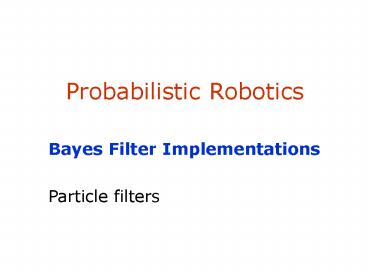Probabilistic Robotics - PowerPoint PPT Presentation
1 / 61
Title:
Probabilistic Robotics
Description:
Randomly insert samples (the robot can be teleported at any point in time) ... In a re-sampling step, new particles are drawn with a probability proportional ... – PowerPoint PPT presentation
Number of Views:36
Avg rating:3.0/5.0
Title: Probabilistic Robotics
1
Probabilistic Robotics
Bayes Filter Implementations Particle filters
2
Sample-based Localization (sonar)
3
Importance Sampling
Weight samples w f / g
4
Distributions
5
Distributions
Wanted samples distributed according to p(x z1,
z2, z3)
6
This is Easy!
We can draw samples from p(xzl) by adding noise
to the detection parameters.
7
Importance Sampling with Resampling
8
Importance Sampling with Resampling
Weighted samples
After resampling
9
Particle Filters
10
Sensor Information Importance Sampling
11
Robot Motion
12
Sensor Information Importance Sampling
13
Robot Motion
14
Particle Filter Algorithm
- Algorithm particle_filter( St-1, ut-1 zt)
- For
Generate new samples - Sample index j(i) from the discrete
distribution given by wt-1 - Sample from using
and - Compute importance weight
- Update normalization factor
- Insert
- For
- Normalize weights
15
Particle Filter Algorithm
16
Resampling
- Given Set S of weighted samples.
- Wanted Random sample, where the probability of
drawing xi is given by wi. - Typically done n times with replacement to
generate new sample set S.
17
Resampling Implementation
- Stochastic universal sampling
- Systematic resampling
- Linear time complexity
- Easy to implement, low variance
- Roulette wheel
- Binary search, n log n
18
Resampling Algorithm
- Algorithm systematic_resampling(S,n)
- For Generate cdf
- Initialize threshold
- For Draw samples
- While ( ) Skip until next threshold
reached - Insert
-
Increment threshold - Return S
Also called stochastic universal sampling
19
Motion Model Reminder
Start
20
Proximity Sensor Model Reminder
Sonar sensor
Laser sensor
21
(No Transcript)
22
(No Transcript)
23
(No Transcript)
24
(No Transcript)
25
(No Transcript)
26
(No Transcript)
27
(No Transcript)
28
(No Transcript)
29
(No Transcript)
30
(No Transcript)
31
(No Transcript)
32
(No Transcript)
33
(No Transcript)
34
(No Transcript)
35
(No Transcript)
36
(No Transcript)
37
(No Transcript)
38
(No Transcript)
39
(No Transcript)
40
Sample-based Localization (sonar)
41
Initial Distribution
42
After Incorporating Ten Ultrasound Scans
43
After Incorporating 65 Ultrasound Scans
44
Estimated Path
45
Using Ceiling Maps for Localization
46
Vision-based Localization
47
Under a Light
Measurement z
P(zx)
48
Next to a Light
Measurement z
P(zx)
49
Elsewhere
Measurement z
P(zx)
50
Global Localization Using Vision
51
Application Rhino and Albert Synchronized in
Munich and Bonn
Robotics And Automation Magazine, to appear
52
Localization for AIBO robots
53
Limitations
- The approach described so far is able to
- track the pose of a mobile robot and to
- globally localize the robot.
- How can we deal with localization errors (i.e.,
the kidnapped robot problem)?
54
Approaches
- Randomly insert samples (the robot can be
teleported at any point in time). - Insert random samples proportional to the average
likelihood of the particles (the robot has been
teleported with higher probability when the
likelihood of its observations drops).
55
Random SamplesVision-Based Localization
- 936 Images, 4MB, .6secs/image
- Trajectory of the robot
56
Odometry Information
57
Image Sequence
58
Resulting Trajectories
Position tracking
59
Resulting Trajectories
Global localization
60
Global Localization
61
Kidnapping the Robot
62
Recovery from Failure
63
Summary
- Particle filters are an implementation of
recursive Bayesian filtering - They represent the posterior by a set of weighted
samples. - In the context of localization, the particles are
propagated according to the motion model. - They are then weighted according to the
likelihood of the observations. - In a re-sampling step, new particles are drawn
with a probability proportional to the likelihood
of the observation.































